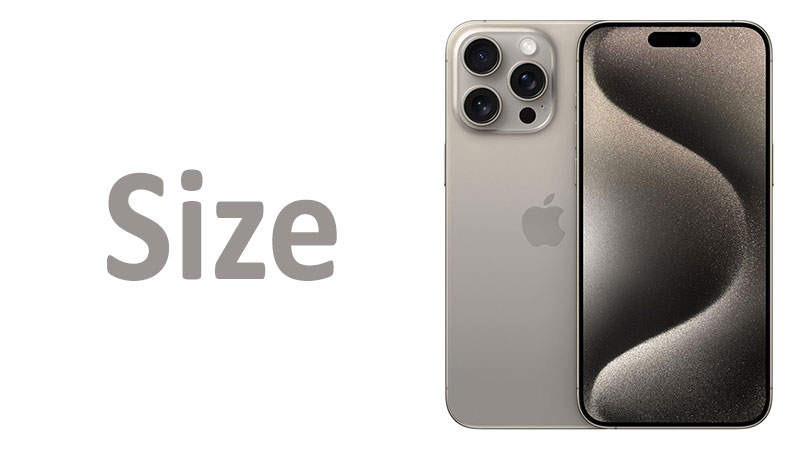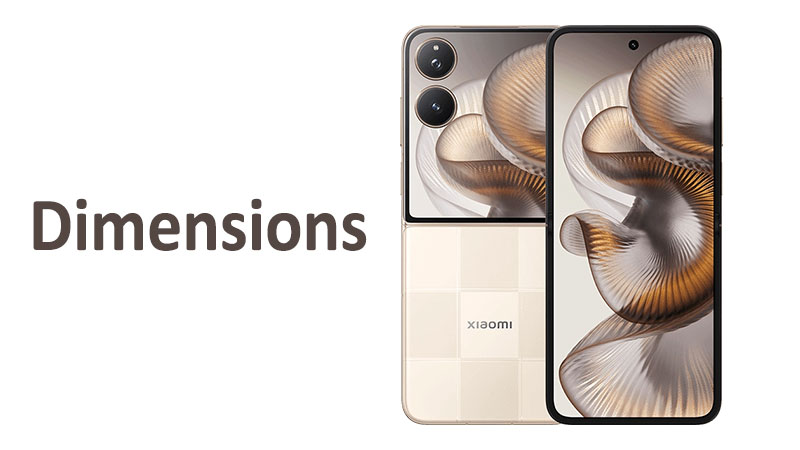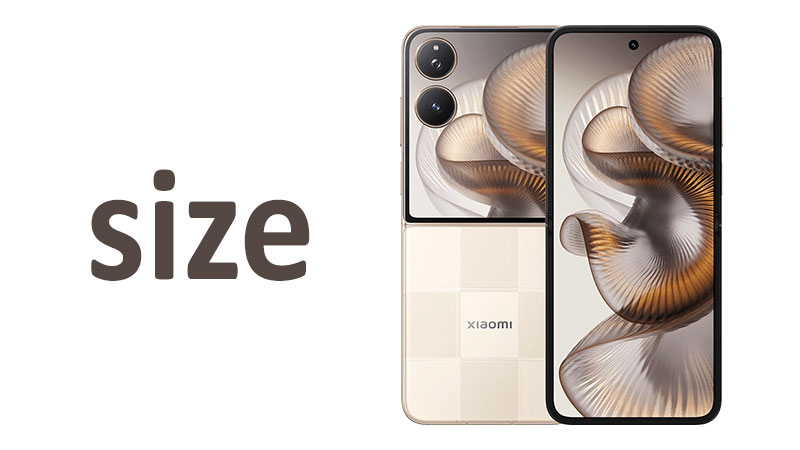The Apple iPhone 15 Pro Max size represents a pivotal point in smartphone design. This flagship model balances a huge display with refined physical dimensions. Understanding these precise measurements is crucial for potential buyers. The size directly affects daily usability, pocket comfort, and media consumption. This detailed analysis covers all aspects of the phone’s physical form. It provides detailed comparisons, discusses the pros and cons, and offers essential buyer information. It ensures you have a complete picture of this mobile powerhouse.
Understanding the Physical Dimensions of the iPhone 15 Pro Max
The overall physical dimensions of a smartphone determine how it feels in your hand. They also dictate its compatibility with accessories. The iPhone 15 Pro Max offers a large, commanding presence. However, it also uses subtle design changes to improve handling.
The Numerical Breakdown of the Chassis
The precise dimensions of the device are 159.9 mm in height, 76.7 mm in width, and 8.3 mm in thickness. Converting these figures to imperial units is also helpful for many users. The height is 6.30 inches, the width is 3.02 inches, and the thickness is 0.33 inches. These figures highlight Apple’s commitment to a consistent large-format phone. These measurements define the chassis from edge to edge.
The overall footprint is slightly smaller than its direct predecessor. Apple achieved this reduction by shrinking the borders around the screen. This seemingly small change significantly affects how the phone looks and feels.
The Impact of the Titanium Frame
Apple introduced a revolutionary titanium alloy frame in this generation. This structural change greatly influences the phone’s size perception. The new titanium construction makes the iPhone 15 Pro Max noticeably lighter than previous Pro Max models. Weight reduction is a critical factor in a large-format device. A lighter phone is easier to hold for long periods.
This new contoured titanium edge replaces the sharp, squared-off stainless steel bands. It also provides a more comfortable resting place for the user’s fingers. Therefore, while the dimensions remain large, the in-hand feel is vastly superior. Buyers appreciate this ergonomic refinement.
A Deeper Look at the 8.3 mm Thickness
The 8.3 mm thickness (0.33 inches) is slightly more substantial than the previous model. This extra depth is necessary to accommodate several new internal components. For example, the advanced camera system requires more physical space. The larger battery also contributes to the increased depth.
However, the new contoured edges mask this slight increase in thickness effectively. The phone does not feel bulky despite the extra measurement. This thickness is still well within the acceptable range for a modern flagship smartphone. It remains a sleek and premium-feeling device. The increased battery life justifies the added dimension for many consumers.
The Display: A 6.7-Inch Marvel
The screen is arguably the single most important component of the Pro Max. Its large size is the primary reason users choose this device. The display measures 6.7 inches diagonally. This size offers an immersive experience for all digital content.
Screen-to-Body Ratio: 89.8% Explained
The display occupies 110.2 cm2 of surface area. This translates to an impressive screen-to-body ratio of approximately 89.8%. This high percentage means the front of the device is almost entirely screen. It shows how efficiently Apple utilizes the available space. A high screen-to-body ratio translates to a more modern and expansive viewing area.
A lower ratio indicates thicker bezels, which detract from the viewing experience. The 89.8% figure confirms the iPhone 15 Pro Max is among the leaders in display immersion. Furthermore, the Dynamic Island replaces the traditional notch, which enhances screen utilization.
The Bezel Reduction Factor
Apple achieved the high 89.8% ratio through significant bezel reduction. The borders surrounding the 6.7-inch display are incredibly thin. These slim bezels are one of the most noticeable aesthetic changes. They pull the user’s focus completely into the content on the screen.
The reduction means the screen size feels even larger and more expansive. This is a subtle yet crucial aspect of the design evolution. It helps maintain the overall compact footprint despite the large display area. The thinned bezels contribute significantly to the phone’s premium look.
ProMotion Technology and Clarity
The 6.7-inch display features Apple’s ProMotion technology. This allows the refresh rate to adapt dynamically up to 120Hz. Motion on the screen is exceptionally fluid and responsive. This high refresh rate enhances gaming and fast scrolling.
The screen also boasts incredibly high pixel density and brightness. Viewing content outdoors is easier than ever before. The large size and advanced technology combine for an unparalleled visual experience. Users appreciate the vibrant colors and deep blacks offered by the Super Retina XDR display.
Specialized Comparisons: Pro Max vs. Pro Max Generations
Comparing the iPhone 15 Pro Max size to its predecessors is essential for current owners considering an upgrade. The differences are not dramatic, but they are meaningful from an ergonomic standpoint.
iPhone 15 Pro Max vs. iPhone 14 Pro Max Size Comparison
The iPhone 14 Pro Max dimensions were 160.7 x 77.6 x 7.85 mm. The new iPhone 15 Pro Max measures 159.9 x 76.7 x 8.3 mm. The 15 Pro Max is shorter, narrower, and slightly thicker than the 14 Pro Max.
The decrease in height (0.8 mm) and width (0.9 mm) is due to the smaller screen bezels. This subtle shrinking makes the 15 Pro Max marginally easier to manage. However, the increase in thickness (0.45 mm) is noticeable due to the advanced camera module. The weight reduction from the titanium frame is perhaps the most critical distinction. This difference in weight changes the feel far more than the minor dimension shifts.
iPhone 15 Pro Max vs. iPhone 13 Pro Max Size Comparison
The iPhone 13 Pro Max measured 160.8 x 78.1 x 7.65 mm. The move from the 13 Pro Max to the 15 Pro Max shows a clearer trend towards a more streamlined design. The 15 Pro Max is significantly narrower and shorter than the 13 Pro Max.
The thickness has increased from 7.65 mm to 8.3 mm, reflecting improved battery capacity and camera upgrades. Users moving from the 13 Pro Max will immediately notice the much lighter weight of the titanium model. They will also appreciate the reduced bezel size. This generational leap provides a substantial upgrade in both size optimization and ergonomics.
Specialized Comparisons: Pro Max vs. Competitors
The iPhone 15 Pro Max size positions it directly against the largest flagship phones from competing brands. Understanding these comparisons helps define its place in the market.
Pro Max vs. Samsung Galaxy S23 Ultra Dimensions
The Samsung Galaxy S23 Ultra is a key competitor in the super-sized phone category. The S23 Ultra dimensions are 163.4 x 78.1 x 8.9 mm. It features a slightly larger 6.8-inch display.
The iPhone 15 Pro Max is notably shorter and slightly narrower than the S23 Ultra. It also boasts a slimmer profile at 8.3 mm compared to 8.9 mm. Therefore, the iPhone offers a marginally more compact feel. This comparison shows that Apple has done an exceptional job of maximizing screen size within a conservative footprint. The S23 Ultra is generally heavier, which also affects usability.
Pro Max vs. Google Pixel 8 Pro Dimensions
The Google Pixel 8 Pro is another major player in the premium smartphone segment. The Pixel 8 Pro measures 162.6 x 76.5 x 8.8 mm. Its display is 6.7 inches, identical to the iPhone’s screen size.
The Pixel 8 Pro is taller and thicker than the iPhone 15 Pro Max. The iPhone is slightly wider but maintains a lower height and thickness. These minor differences mean the iPhone fits better in some pockets. It also provides a slightly sleeker appearance due to its lower profile. The choice between these two often comes down to personal preference regarding width and height.
The Ergonomics of a Large Phone
Size is not just a specification; it is a fundamental aspect of the user experience. Ergonomics focuses on how comfortable and practical a device is to use daily.
One-Handed Use and Grip Comfort
The large 6.7-inch screen size inherently challenges true one-handed operation. Reaching the top corner requires hand adjustments or assistive technology. However, the slightly reduced width (76.7 mm) improves gripability compared to older Pro Max models. The contoured edges of the titanium frame also enhance comfort significantly.
Most users will still require two hands for full screen access, especially for typing or navigating menus. Apple includes features like Reachability to help mitigate this issue. This feature temporarily brings the top of the screen closer to the thumb.
Pocketability and Portability
The dimensions of 159.9 x 76.7 x 8.3 mm define the phone’s pocket fit. It will easily fit into standard pant and jacket pockets. However, its large size may feel cumbersome in tight or shallow pockets. This is a common trade-off for any phone with a 6.7-inch display. The slightly reduced weight improves portability, making it less likely to drag down clothing.
Users should consider their typical wardrobe when purchasing a phone of this size. Carrying a phone this large often encourages the use of an external bag or pouch. This consideration is particularly important for active individuals.
Action Button and Accessibility
The new Action Button is located on the side of the device. Its placement is optimized for thumb access, regardless of the phone’s large size. This customization feature enhances accessibility for common tasks. Users can initiate actions without navigating the large screen.
The button’s strategic positioning compensates for the challenge of reaching across the wide display. This adds a layer of convenience to the overall ergonomic design. It shows that Apple considers usability alongside sheer size.
Pros and Cons of the Pro Max Size
The decision to buy the iPhone 15 Pro Max involves weighing its large size benefits against its drawbacks. The size is its most defining characteristic.
Pros: Screen Real Estate and Immersion
The 6.7-inch screen size offers massive advantages for content consumption. Watching videos, viewing photos, and playing games are deeply immersive experiences. The expansive display allows for more comfortable viewing of detailed spreadsheets or documents.
Furthermore, the larger chassis accommodates a significantly larger battery. This is a major benefit for power users. Excellent battery life is often cited as the biggest reason for choosing the Pro Max model. The size directly translates to superior endurance.
Cons: Handling and Cost
The primary drawback of the Pro Max size is its handling difficulty. Users with smaller hands may find the device unwieldy and tiring to hold. The increased physical size also means a higher risk of accidental drops. Furthermore, the sheer size contributes to the higher cost. The Pro Max is the most expensive iPhone model.
Its large footprint makes casual storage inconvenient. It also demands a protective case, which adds further to the overall dimensions. This size premium is a constant factor that buyers must consider.
Essential Buyer and Reader Insights
For consumers researching the iPhone 15 Pro Max, several size-related factors are crucial for a satisfying purchase.
Case Selection Considerations
Choosing a case for the iPhone 15 Pro Max is particularly important. A thick, rugged case will negate the ergonomic improvements of the titanium frame. It will also significantly increase the overall dimensions and weight. The thickness of 8.3 mm combined with a heavy-duty case can make the phone feel truly bulky.
Buyers should look for slim, lightweight cases to maintain the phone’s optimized form factor. It is important to find a balance between protection and minimal bulk. The case should complement the phone’s refined size, not detract from it.
Weight Distribution and Balance
The switch to titanium resulted in excellent weight distribution across the device. The phone feels balanced and less top-heavy than previous iterations. This is important for sustained use, such as reading or watching a movie. Poor weight distribution can cause wrist fatigue quickly.
The titanium design ensures the phone feels premium and solid without being overly dense. Test holding the phone without a case is the best way to appreciate this balance. Case weight selection should also prioritize maintaining this equilibrium.
The Importance of Size in Photography and Media
The 6.7-inch screen size is ideal for mobile photographers. It provides a large, accurate viewfinder for composing shots. It also makes editing photos directly on the phone much easier and more precise. The display size improves the post-processing workflow significantly.
Similarly, media creators benefit from the increased screen real estate. Video editing and graphic design tasks are more practical on this large canvas. The size of the display enhances productivity for creative professionals.
The Technology Driving Size Efficiency
The impressive 89.8% screen-to-body ratio is a testament to sophisticated engineering. Several technological advancements allow for this efficient design.
Packaging Density and Internal Layout
Apple engineers maximize internal component density. This efficient packaging minimizes wasted space within the 159.9 x 76.7 x 8.3 mm chassis. The logic board and other internal modules are layered compactly. This meticulous design allows for both a large screen and a large battery.
The smaller, more efficient A17 Pro chip also helps save internal space. Every millimeter is utilized to achieve the perfect balance of performance and size. This level of packaging is crucial for flagship devices.
Camera System Integration
The 8.3 mm thickness is partly dictated by the camera system, particularly the new tetraprism telephoto lens. This periscope-style lens allows for 5x optical zoom. It requires physical depth to house the folded optics. This innovative design maximizes zoom capability without a significantly thicker camera bump.
The camera module still protrudes, but the overall chassis thickness provides stability. The engineering solution allows high-end photography in a relatively thin form factor. This compromise between thickness and photographic power is necessary.
The Financial Aspect of Size
The sheer size of the iPhone 15 Pro Max also impacts the financial aspect of ownership. The large components contribute to the higher manufacturing cost.
Component Pricing
The expansive 6.7-inch Super Retina XDR display is one of the most expensive components. Larger screens cost more to manufacture than smaller ones. Similarly, the extensive titanium frame requires a complex and costly milling process. These high-value components justify the Pro Max’s premium price point.
The cost is directly linked to the device’s physical magnitude and the materials used. Consumers pay a premium for the maximum screen size and corresponding advanced features.
Resale Value Considerations
The Pro Max models historically retain their value better than the standard models. The desirability of the large screen size and extended battery life drives this trend. Buyers who prioritize size and battery capacity are willing to pay more on the secondary market.
Therefore, the investment in the larger device often provides better resale value retention. This can offset some of the initial high purchase price. The large form factor is a long-term desirable feature.
The Future of Large Phone Sizes
The iPhone 15 Pro Max size provides a clear indication of Apple’s long-term strategy. The company will likely continue optimizing the screen-to-body ratio.
Bezel Reduction Limits
The current 89.8% screen-to-body ratio is approaching its physical limit. Future design innovations will focus on fully eliminating the remaining bezels. This might be achieved through entirely under-display cameras and sensors. This would maximize the usable 6.7-inch display area.
The goal is to achieve a completely uninterrupted screen experience. The dimensions themselves may not change drastically from 159.9 x 76.7 x 8.3 mm. Instead, the display efficiency will improve incrementally.
The Role of Folding Technology
The rise of folding smartphones presents a challenge to the traditional large phone design. Devices that fold open offer even larger screen sizes when needed. Apple’s commitment to the Pro Max size suggests they view the large candybar format as a stable, primary form factor.
The 6.7-inch display remains the upper limit for a comfortable single-slab phone. Folding phones are a separate category addressing different needs. The iPhone 15 Pro Max solidifies the importance of the maximum size slab phone.
Final Thoughts and Conclusion
The Apple iPhone 15 Pro Max size is a masterclass in dimension management. It successfully combines a huge 6.7-inch display with a manageable chassis size. The precise dimensions are 159.9 x 76.7 x 8.3 mm. The 89.8% screen-to-body ratio maximizes the viewing area. The titanium frame provides significant weight savings and improved ergonomics.
For buyers, the choice is simple: prioritize screen immersion and battery life. If you consume large amounts of media or rely heavily on your phone, the size is a massive benefit. If one-handed use and ultimate portability are your priorities, a smaller model is better. The iPhone 15 Pro Max size is optimized for maximum performance and user experience. It sets the standard for large-format flagship devices. Choose the Pro Max for an uncompromising mobile experience.
Frequently Asked Questions (FAQ)
What is the exact screen size of the iPhone 15 Pro Max?
The screen size is 6.7 inches diagonally. This provides a viewing area of 110.2 cm2.
How much wider is the iPhone 15 Pro Max than the Pro model?
The iPhone 15 Pro Max is 76.7 mm wide. The standard iPhone 15 Pro is 70.6 mm wide. This is a 6.1 mm difference.
What causes the 8.3 mm thickness of the Pro Max?
The 8.3 mm thickness is necessary to house the large battery and the advanced tetraprism telephoto camera system.
Did the iPhone 15 Pro Max get physically smaller than the 14 Pro Max?
Yes, it is slightly shorter (159.9 mm vs 160.7 mm) and slightly narrower (76.7 mm vs 77.6 mm) due to thinner screen bezels.
Does the titanium frame make a noticeable difference in weight?
Yes, the titanium frame provides a significant and noticeable weight reduction compared to the previous stainless steel Pro Max models.



